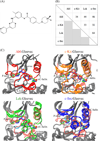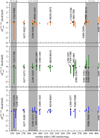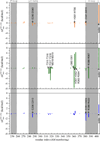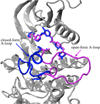Computational analysis of the binding specificity of Gleevec to Abl, c-Kit, Lck, and c-Src tyrosine kinases
- PMID: 24001034
- PMCID: PMC4026022
- DOI: 10.1021/ja405939x
Computational analysis of the binding specificity of Gleevec to Abl, c-Kit, Lck, and c-Src tyrosine kinases
Abstract
Gleevec, a well-known cancer therapeutic agent, is an effective inhibitor of several tyrosine kinases, including Abl and c-Kit, but displays less potency to inhibit closely homologous tyrosine kinases, such as Lck and c-Src. Because many structural features of the binding site are highly conserved in these homologous kinases, the molecular determinants responsible for the binding specificity of Gleevec remain poorly understood. To address this issue, free energy perturbation molecular dynamics (FEP/MD) simulations with explicit solvent was used to compute the binding affinity of Gleevec to Abl, c-Kit, Lck, and c-Src. The results of the FEP/MD calculations are in good agreement with experiments, enabling a detailed and quantitative dissection of the absolute binding free energy in terms of various thermodynamic contributions affecting the binding specificity of Gleevec to the kinases. Dominant binding free energy contributions arises from the van der Waals dispersive interaction, compensating about two-thirds of the unfavorable free energy penalty associated with the loss of translational, rotational, and conformational freedom of the ligand upon binding. In contrast, the contributions from electrostatic and repulsive interactions nearly cancel out due to solvent effects. Furthermore, the calculations show the importance of the conformation of the kinase activation loop. Among the kinases examined, Abl provides the most favorable binding environment for Gleevec via optimal protein-ligand interactions and a small free energy cost for loss of the translational, rotational, and conformational freedom upon ligand binding. The FEP/MD calculations additionally reveal that Lck and c-Src provide similar nonbinding interactions with the bound-Gleevec, but the former pays less entropic penalty for the ligand losing its translational, rotational, and conformational motions to bind, examining the empirically observed differential binding affinities of Gleevec between the two Src-family kinases.
Figures






Similar articles
-
Computational study of Gleevec and G6G reveals molecular determinants of kinase inhibitor selectivity.J Am Chem Soc. 2014 Oct 22;136(42):14753-62. doi: 10.1021/ja504146x. Epub 2014 Oct 7. J Am Chem Soc. 2014. PMID: 25243930 Free PMC article.
-
Explaining why Gleevec is a specific and potent inhibitor of Abl kinase.Proc Natl Acad Sci U S A. 2013 Jan 29;110(5):1664-9. doi: 10.1073/pnas.1214330110. Epub 2013 Jan 14. Proc Natl Acad Sci U S A. 2013. PMID: 23319661 Free PMC article.
-
Conformation-selective inhibitors reveal differences in the activation and phosphate-binding loops of the tyrosine kinases Abl and Src.ACS Chem Biol. 2013 Dec 20;8(12):2734-43. doi: 10.1021/cb400663k. Epub 2013 Oct 29. ACS Chem Biol. 2013. PMID: 24106839 Free PMC article.
-
Protein kinase inhibitors.Folia Biol (Praha). 2006;52(4):137-48. Folia Biol (Praha). 2006. PMID: 17116285 Review.
-
Protein tyrosine kinases: autoregulation and small-molecule inhibition.Curr Opin Struct Biol. 2002 Dec;12(6):735-41. doi: 10.1016/s0959-440x(02)00383-4. Curr Opin Struct Biol. 2002. PMID: 12504677 Review.
Cited by
-
c-Abl Deficiency Provides Synaptic Resiliency Against Aβ-Oligomers.Front Cell Neurosci. 2019 Nov 26;13:526. doi: 10.3389/fncel.2019.00526. eCollection 2019. Front Cell Neurosci. 2019. PMID: 31849613 Free PMC article.
-
Scalable Inhibitors of the Nsp3-Nsp4 Coupling in SARS-CoV-2.ACS Omega. 2023 Feb 6;8(6):5349-5360. doi: 10.1021/acsomega.2c06384. eCollection 2023 Feb 14. ACS Omega. 2023. PMID: 36798146 Free PMC article.
-
Equilibrium and Nonequilibrium Ensemble Methods for Accurate, Precise and Reproducible Absolute Binding Free Energy Calculations.J Chem Theory Comput. 2025 Jan 14;21(1):440-462. doi: 10.1021/acs.jctc.4c01389. Epub 2024 Dec 16. J Chem Theory Comput. 2025. PMID: 39680850 Free PMC article.
-
Tuning Local Hydration Enables a Deeper Understanding of Protein-Ligand Binding: The PP1-Src Kinase Case.J Phys Chem Lett. 2021 Jan 14;12(1):49-58. doi: 10.1021/acs.jpclett.0c03075. Epub 2020 Dec 10. J Phys Chem Lett. 2021. PMID: 33300337 Free PMC article.
-
Evolution and intelligent design in drug development.Front Mol Biosci. 2015 May 21;2:27. doi: 10.3389/fmolb.2015.00027. eCollection 2015. Front Mol Biosci. 2015. PMID: 26052517 Free PMC article.
References
-
- Buchdunger E, Zimmermann J, Mett H, Meyer T, Muller M, Druker BJ, Lydon NB. Cancer Res. 1996;56:100. - PubMed
-
- Lydon N. Nat. Med. 2009;15:1153. - PubMed
-
- Druker BJ, Tamura S, Buchdunger E, Ohno S, Segal GM, Fanning S, Zimmermann J, Lydon NB. Nat. Med. 1996;2:561. - PubMed
-
- Sawyers CL, Hochhaus A, Feldman E, Goldman JM, Miller CB, Ottmann OG, Schiffer CA, Talpaz M, Guilhot F, Deininger MW, Fischer T, O'Brien SG, Stone RM, Gambacorti-Passerini CB, Russell NH, Reiffers JJ, Shea TC, Chapuis B, Coutre S, Tura S, Morra E, Larson RA, Saven A, Peschel C, Gratwohl A, Mandelli F, Ben-Am M, Gathmann I, Capdeville R, Paquette RL, Druker BJ. Blood. 2002;99:3530. - PubMed
Publication types
MeSH terms
Substances
Grants and funding
LinkOut - more resources
Full Text Sources
Other Literature Sources
Miscellaneous

